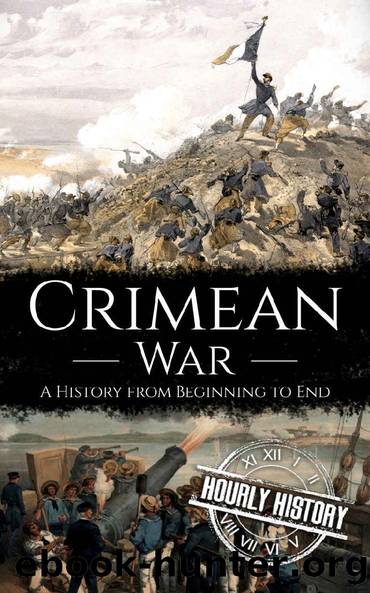Crimean War: A History from Beginning to End by Hourly History

Author:Hourly History [History, Hourly]
Language: eng
Format: epub
Published: 2020-03-22T00:00:00+00:00
Chapter Six
Inkerman and the Death of the Tsar
âSevastopol is probably the worst battered town in Russia or anywhere else.â
âMark Twain
After the failed Russian attempt to disrupt British supply lines during the Battle of Balaclava, the siege of Sevastopol settled down into a period of stalemate. The French and British forces had around 120 artillery pieces set up to fire on Sevastopol from a series of redoubts, lines of trenches, and fortified gun positions. Inside the city, the Russian defenders had more than 300 guns, many taken from naval vessels which had been deliberately scuttled in the harbor. Most of the defenders were Russian naval personnel and marines from these ships.
An artillery duel between the French and British guns outside and the Russian weapons inside began. For the most part, this produced few decisive results though in early October a Russian shell fell on a French magazine, causing it to explode and destroying a number of guns and killing many of their operators. A short time later, a British shell hit the magazine in a Russian redoubt, killing an admiral and destroying several guns.
The guns in the siege lines around the city were supplemented by Allied naval forces which also bombarded Sevastopol, though to little effect. The well-prepared Russian defensive positions proved to be extremely resilientâin early October, a flotilla of more than 25 allied warships bombarded Russian defenses and shore batteries. Little damage was caused and this was repaired during the night. The allied warships meanwhile lost more than 300 men to intense Russian return fire.
Both defenders and attackers dug trench systems and rifle pits from which they could snipe at enemy lines, an early foretaste of the trench warfare of World War I. For the allies, one of the main problems was that they simply did not have sufficient troops to man the long siege line which ran all the way around the city. Instead, allied troops were concentrated in small fortified positions, generally redoubts on top of low hills.
Although the Battle of Balaclava had been a failure, it had made the Russians aware of how thinly stretched the allied forces were. Prince Menshikov, the Russian commander with overall responsibility for the defense of Sevastopol, had withdrawn the bulk of his field army from the city before the allied siege lines were complete, leaving the defense to a garrison of mainly naval troops. In early morning fog on November 5, Menshikov unleashed more than 40,000 Russian troops from outside the siege lines supported by more than 100 field guns to attack allied lines.
The main thrust of the Russian attack was to fall on a British position, Home Hill, where the Second Division had prepared defensive positions for around 2,500 hundred men supported by just 12 field guns. On paper, the Russian attack looked unstoppable. However, the sheer number of attackers proved to be an issue, and only around 15,000 Russian troops were able to attack Home Hill. The acting commander of the Second Division, Major-General John Pennefather, was uncertain
Download
This site does not store any files on its server. We only index and link to content provided by other sites. Please contact the content providers to delete copyright contents if any and email us, we'll remove relevant links or contents immediately.
| Africa | Americas |
| Arctic & Antarctica | Asia |
| Australia & Oceania | Europe |
| Middle East | Russia |
| United States | World |
| Ancient Civilizations | Military |
| Historical Study & Educational Resources |
Magic and Divination in Early Islam by Emilie Savage-Smith;(1501)
Ambition and Desire: The Dangerous Life of Josephine Bonaparte by Kate Williams(1346)
Bohemians, Bootleggers, Flappers, and Swells: The Best of Early Vanity Fair by Bohemians Bootleggers Flappers & Swells- The Best of Early Vanity Fair (epub)(1344)
Papillon by Henry Charrière(1311)
Twelve Caesars by Mary Beard(1258)
Operation Vengeance: The Astonishing Aerial Ambush That Changed World War II by Dan Hampton(1138)
What Really Happened: The Death of Hitler by Robert J. Hutchinson(1131)
London in the Twentieth Century by Jerry White(1114)
Time of the Magicians by Wolfram Eilenberger(1089)
The Japanese by Christopher Harding(1086)
Twilight of the Gods by Ian W. Toll(1084)
Lenin: A Biography by Robert Service(1045)
The Devil You Know by Charles M. Blow(985)
A Social History of the Media by Peter Burke & Peter Burke(940)
Freemasons for Dummies by Hodapp Christopher;(923)
Napolean Hill Collection by Napoleon Hill(905)
Henry III by David Carpenter;(892)
The Churchill Complex by Ian Buruma(884)
The Rise and Triumph of the Modern Self by Unknown(880)
